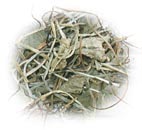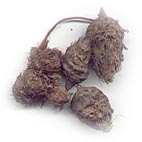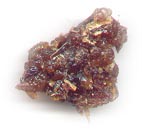




The use of Cissus quadrangularis for medicinal purposes dates back thousands of years. Cissus quadrangularis, a succulent vine plant native to India. Cissus quadrangularis, first prescribed in ancient Ayurvedic texts, has been used throughout history for its analgesic properties. Cissus quadrangularis is a known medicinal plant that is used in modern day for many of the same reasons it was used in ancient times. In India, people use Cissus quadrangularis regularly to treat eye disease, ear disease, irregular menstruation, Fracture, anorexia, burns and muscle pain. Theories suggest that Cissus quadrangularis can accelerate recovery rates by influencing the speed at which fractures and tissues heal. The use of Cissus quadrangularis for bone fractures was found to reduce the recovery time by more than 55 percent in clinical studies. Cissus quadrangularis finds application in Weight management and sports nutrition products due to its diuretic property.

Centella asiatica (also known as gotu kola, Indian Pennywort and Mandookaparni) has been used for centuries as a medicinal herb and was referred to in the French pharmacopoeia in 1884, as well as the ancient traditional Chinese shennong Herbal some 2,000 years ago, as well as in Indian Ayurvedic medicine some 3,000 years ago. In Sanskrit texts, this plant is called Brahmi and Mandukapani. According to Ainslie Centella asiatica leaves were used for pediatric complaints in bowel problems, fever and applied externally for blows and bruises in the Coromandel Coast. In Java, according to horsfield, they are considered diuretic and on the Malabar Coast, Centella asiatica plant is one of the remedies for leprosy. As a remedy in this disease it was first brought prominently to notice by Boileau, in 1859. Dr. A. Hunter, who tried it in the Madras leper Ho pital, came to the conclusion that it had no claim to consideration as a specific in leprosy, but he found it most useful in ameliorating the symptoms and improving general health. It has also found to have memory boosting property and hence used in memory enhancing products.

Cyprus rotundus also called as Mustaka was held in high esteem by the ancient sage’s of India. Cyprus rotundus has been used throughout the ages for the treatment of numerous illnesses. Cyprus rotundus enjoys an important place among medicinal herbs in India since ancient times. Vagbhata has admired Cyprus rotundus as the drug of choice for any type of fever. He has also mentioned Cyprus rotundus as dipaniya – an appetizer, pacaniya- digestant and sangrahi – anti – diarrhea. Maharishi Charka has categorized it as trptighna – anti-saturative, trsna nigra – haniya – thirst relieving, lekhaniya – reducing herb, kandughna – anti-pruritic and stany sodhana – lactodepurant herb. Cyprus rotundus is also well known for its amapacaka – digests ama and svedala – diaphoretic properties. The bulbous roots of Cyprus rotundus have great medicinal value and are used for medicinal purpose. It is used both, internally as well as externally. Cyprus rotundus extract oil instilled into eyes in conjunctivitis reduces the pain, redness and ocular discharges. The external application of Cyprus rotundus paste relieves itching and reduces the foul odor due to excessive sweating, and is salutary in skin diseases like scabies, eczema etc. In obesity, the massage with its dry powder (udvartana) is extremely beneficial for reducing the subcutaneous fat deposition. Internally, Cyprus rotundus is used in vast range of diseases. Cyprus rotundus is one of the best herbs, useful in digestive disorders. Cyprus rotundus is a keen stimulant for appetite, digestion, digestion of ama, and is also vermicide, astringent. Therefore, Cyprus rotundus is an effective remedy for distaste, vomiting, diarrhea, colitis, dyspepsia, worms etc, Cyprus rotundus is highly praised as the best panacea for dental diarrhea in children. Cyprus rotundus works well in combination with karkatasrngi (Rhus succedanea) and ativisa (Aconitum heterophyllum) in such condition. Cyprus rotundus dental ciarrhoea, traditionally, the decoction of mustaka combined with mustaka powder (1gm) is given with great benefit. Cyprus rotundus mental debility and epilepsy, it is given along with cow’s milk. Cyprus rotundus also promotes the intelligent whereas, mustaka is potent amapacaka (digests the ama). Hence, mustaka should be used in diarrhea, associated with fever and excessive thirst. Cyprus rotundus is beneficial in cough and asthma as it alleviates the kapha Mustaka is the best herb for treating any type of fever. The decoction of Cyprus rotundus roots is the best remedy for purifying the breast milk in lactation mothers. Cyprus rotundus is also one of the most effective menstrual regulators. Cyprus rotundus helps to promote and regulate the menstruation (emmenagogue). As an emmenagogue, Cyprus rotundus can be used with satavari (Asparagus racemosus) in proportions of 1:4 in burning micturition, urinary calculi; heamaturia etc. Cyprus rotundus renders excellent results, as it is diuretic in property.

Commiphora mukul plays an important role in the Indian medical system Ayurveda in formulas for rheumatoid arthritis and lipid disorders. Early beliefs (2,600 years ago) also assigned a weight-reducing effect and a cardiovascular protective effect to Commiphora mukul, in addition to its anti-inflammatory and lipid-lowering effects. This led to studies of gugulipid's hypolipidemic effect on both cholesterol and triglycerides, and its approval in India as a lipid-lowering drug in 1986. Commiphora mukul lowers serum levels of triglycerides and cholesterol by stimulating the liver to increase the uptake of the lipoproteins VLDL and LDL, respectively. Commiphora mukul has also been shown to increase blood levels of HDL, providing a cardioprotective benefit; therefore, gugulipid would be most beneficial in treating Type IIb and IV hyperlipoproteinemias. In animal studies, gugulipid reversed the deposition of pre-existing atherosclerotic plaques, promoted fibrinolysis, inhibited platelet aggregation and functioned as a free-radical scavenger, all serving a cardioprotective function. Commiphora mukul anti-inflammatory action is thought to be due to inhibition of delayed hypersensitivity reactions. The sterol is approximately equivalent to ibuprofen and 1/5 the effect of hydrocortisone. Commiphora mukul is a fairly nontoxic product, having an LD50 in rats of 1.6g/kg. In doses used for clinical efficacy, there may be mild skin rashes or GI upset/diarrhea. Commiphora mukul is safe to use during pregnancy and does not adversely affect liver or kidney function, hematological tests or blood sugar levels in diabetic patients.
